ECON 6: Analysis of the Causes of the Great Recession in the USA
VerifiedAdded on 2020/02/18
|9
|2569
|34
Essay
AI Summary
This essay, prepared for an Economics for Managers course, delves into the causes and consequences of the Great Recession in the USA. It examines key factors such as the housing market crash, the role of subprime mortgages, and the impact of monetary policy decisions. The essay also explores the effects of the recession on the US labor market, the financial sector, and the global economy, including the impact on countries like India. It discusses the role of factors like overvalued assets, lack of regulation, and the complexities of national debt in exacerbating the crisis. Furthermore, it analyzes the impact on unemployment rates and the devaluation of the US dollar. The essay concludes by highlighting the lasting effects of the recession and the importance of understanding its causes to prevent similar crises in the future. The author also includes references to scholarly articles that support the arguments made in the essay.
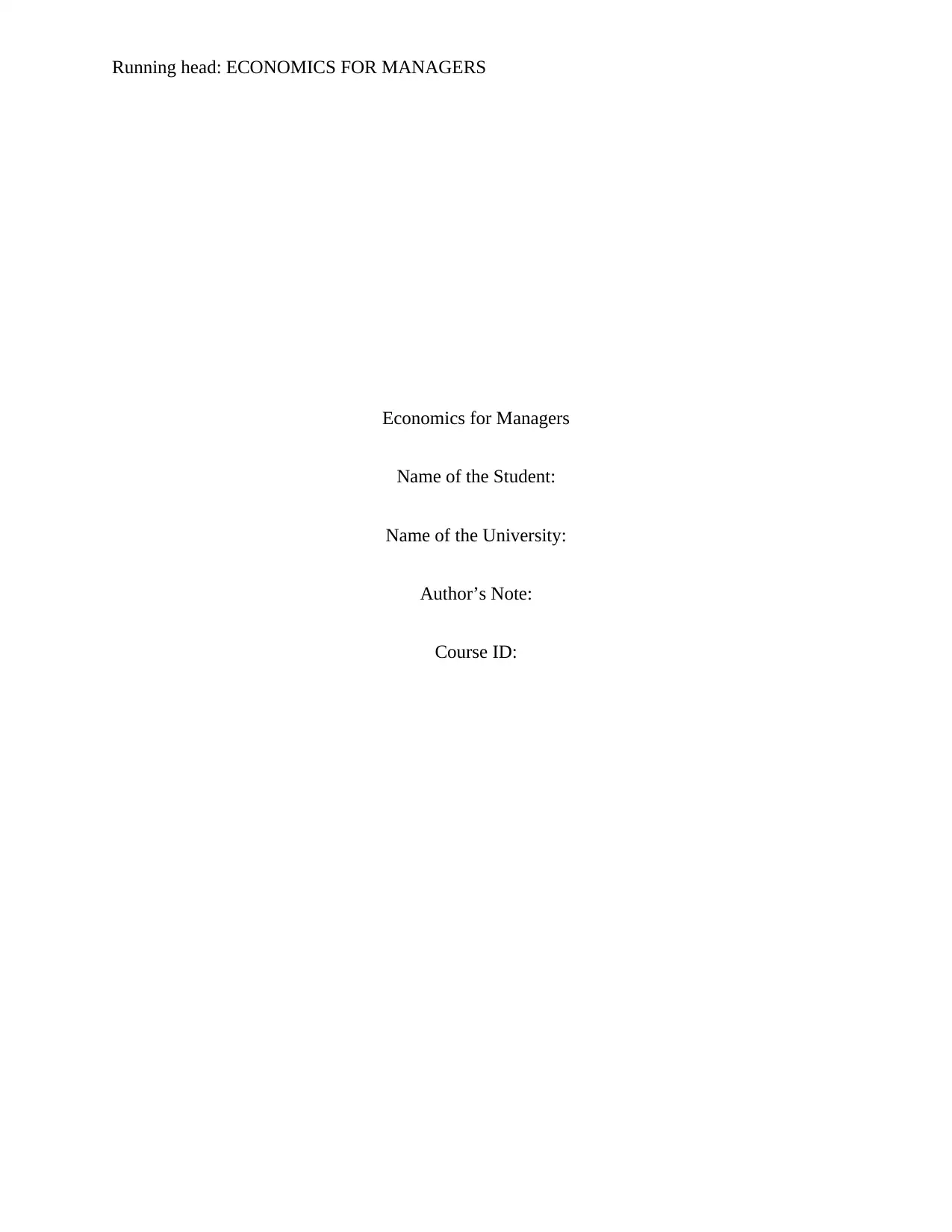
Running head: ECONOMICS FOR MANAGERS
Economics for Managers
Name of the Student:
Name of the University:
Author’s Note:
Course ID:
Economics for Managers
Name of the Student:
Name of the University:
Author’s Note:
Course ID:
Paraphrase This Document
Need a fresh take? Get an instant paraphrase of this document with our AI Paraphraser

1ECONOMICS FOR MANAGERS
Introduction:
Recession could be termed as a considerable fall in the spread of economic activity
throughout the economy, which has lasted for much time. This has been visible normally in real
gross domestic product (GDP), employment, actual income, sales associated with retail and
wholesale along with industrial production (Aguiar, Hurst and Karabarbounis 2013). The
recession of US has resulted in a global financial crisis that has shattered the confidence of the
consumers and businesses in many nations like China, European Union and other Asian nations.
Due to this, the Great Recession of the US has been named causing financial downfall in the US
and it has spread out rapidly to the other global nations. Therefore, the current essay aims to
discuss the main causes that have lead to the Great Recession in USA.
Main causes of the Great Recession in USA:
It has been observed that USA had encountered severe issues like banks about to be \
come bankrupt, greater public debt levels, declining share market, imminent recession threat and
frozen money markets. In the words of Bianchi and Melosi (2017), the international imbalances,
risk perceptions, rates of interest and financial system regulation have affected the global
financial crisis. There are certain major causes that have lead to the causes of the Great
Recession in US. One of such causes is the housing crash, in which the US housing market is a
main consumer spending and economic growth rate determinants. Certain factors influence the
housing prices to increase at a faster rate in contrast to the consumer incomes and these have
resulted in overvalued assets. At the time housing prices fail to rectify the imbalance, it had
considerable influence on the spending power of the consumers, in which the individuals could
not remortgage in obtaining additional capital for spending (Bitler and Hoynes 2015).
Introduction:
Recession could be termed as a considerable fall in the spread of economic activity
throughout the economy, which has lasted for much time. This has been visible normally in real
gross domestic product (GDP), employment, actual income, sales associated with retail and
wholesale along with industrial production (Aguiar, Hurst and Karabarbounis 2013). The
recession of US has resulted in a global financial crisis that has shattered the confidence of the
consumers and businesses in many nations like China, European Union and other Asian nations.
Due to this, the Great Recession of the US has been named causing financial downfall in the US
and it has spread out rapidly to the other global nations. Therefore, the current essay aims to
discuss the main causes that have lead to the Great Recession in USA.
Main causes of the Great Recession in USA:
It has been observed that USA had encountered severe issues like banks about to be \
come bankrupt, greater public debt levels, declining share market, imminent recession threat and
frozen money markets. In the words of Bianchi and Melosi (2017), the international imbalances,
risk perceptions, rates of interest and financial system regulation have affected the global
financial crisis. There are certain major causes that have lead to the causes of the Great
Recession in US. One of such causes is the housing crash, in which the US housing market is a
main consumer spending and economic growth rate determinants. Certain factors influence the
housing prices to increase at a faster rate in contrast to the consumer incomes and these have
resulted in overvalued assets. At the time housing prices fail to rectify the imbalance, it had
considerable influence on the spending power of the consumers, in which the individuals could
not remortgage in obtaining additional capital for spending (Bitler and Hoynes 2015).
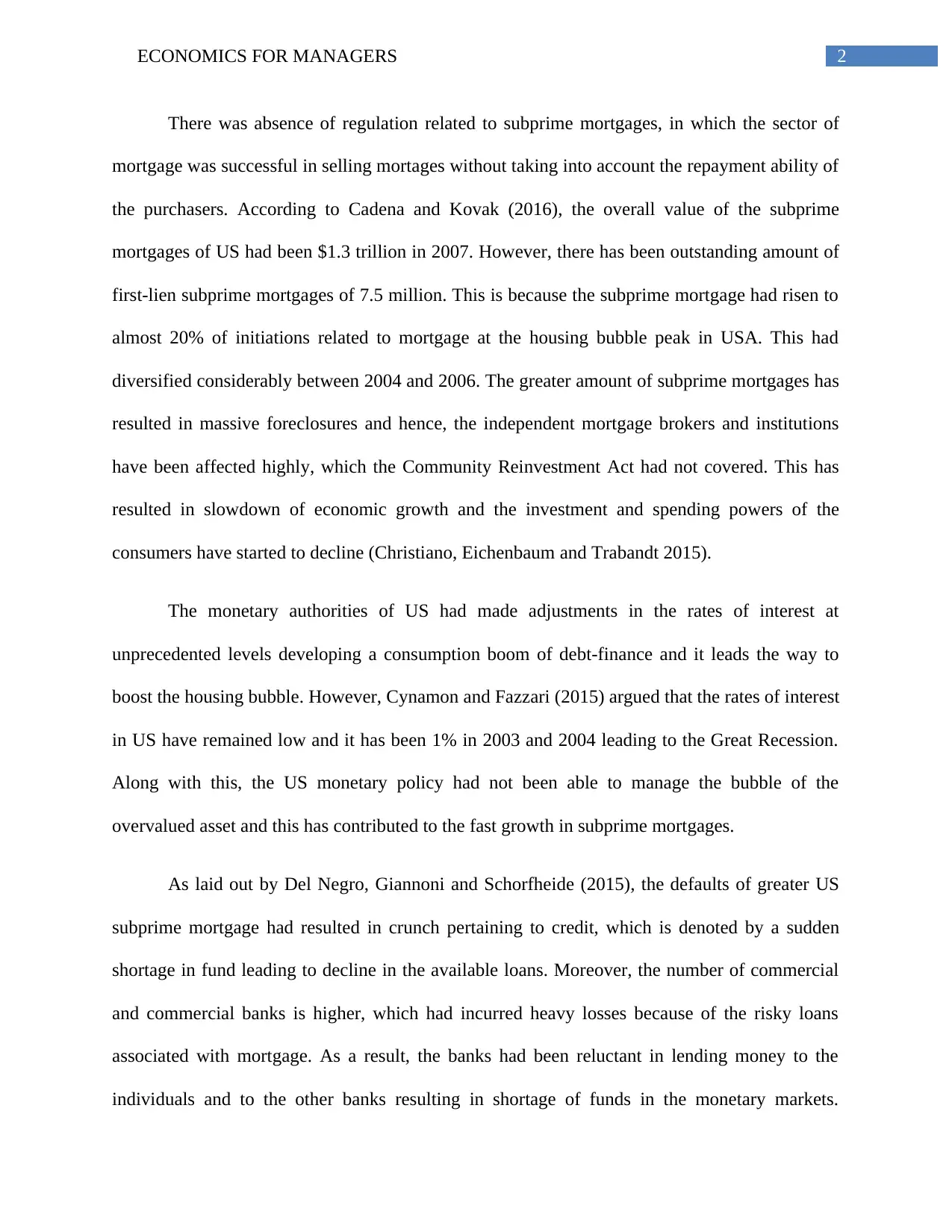
2ECONOMICS FOR MANAGERS
There was absence of regulation related to subprime mortgages, in which the sector of
mortgage was successful in selling mortages without taking into account the repayment ability of
the purchasers. According to Cadena and Kovak (2016), the overall value of the subprime
mortgages of US had been $1.3 trillion in 2007. However, there has been outstanding amount of
first-lien subprime mortgages of 7.5 million. This is because the subprime mortgage had risen to
almost 20% of initiations related to mortgage at the housing bubble peak in USA. This had
diversified considerably between 2004 and 2006. The greater amount of subprime mortgages has
resulted in massive foreclosures and hence, the independent mortgage brokers and institutions
have been affected highly, which the Community Reinvestment Act had not covered. This has
resulted in slowdown of economic growth and the investment and spending powers of the
consumers have started to decline (Christiano, Eichenbaum and Trabandt 2015).
The monetary authorities of US had made adjustments in the rates of interest at
unprecedented levels developing a consumption boom of debt-finance and it leads the way to
boost the housing bubble. However, Cynamon and Fazzari (2015) argued that the rates of interest
in US have remained low and it has been 1% in 2003 and 2004 leading to the Great Recession.
Along with this, the US monetary policy had not been able to manage the bubble of the
overvalued asset and this has contributed to the fast growth in subprime mortgages.
As laid out by Del Negro, Giannoni and Schorfheide (2015), the defaults of greater US
subprime mortgage had resulted in crunch pertaining to credit, which is denoted by a sudden
shortage in fund leading to decline in the available loans. Moreover, the number of commercial
and commercial banks is higher, which had incurred heavy losses because of the risky loans
associated with mortgage. As a result, the banks had been reluctant in lending money to the
individuals and to the other banks resulting in shortage of funds in the monetary markets.
There was absence of regulation related to subprime mortgages, in which the sector of
mortgage was successful in selling mortages without taking into account the repayment ability of
the purchasers. According to Cadena and Kovak (2016), the overall value of the subprime
mortgages of US had been $1.3 trillion in 2007. However, there has been outstanding amount of
first-lien subprime mortgages of 7.5 million. This is because the subprime mortgage had risen to
almost 20% of initiations related to mortgage at the housing bubble peak in USA. This had
diversified considerably between 2004 and 2006. The greater amount of subprime mortgages has
resulted in massive foreclosures and hence, the independent mortgage brokers and institutions
have been affected highly, which the Community Reinvestment Act had not covered. This has
resulted in slowdown of economic growth and the investment and spending powers of the
consumers have started to decline (Christiano, Eichenbaum and Trabandt 2015).
The monetary authorities of US had made adjustments in the rates of interest at
unprecedented levels developing a consumption boom of debt-finance and it leads the way to
boost the housing bubble. However, Cynamon and Fazzari (2015) argued that the rates of interest
in US have remained low and it has been 1% in 2003 and 2004 leading to the Great Recession.
Along with this, the US monetary policy had not been able to manage the bubble of the
overvalued asset and this has contributed to the fast growth in subprime mortgages.
As laid out by Del Negro, Giannoni and Schorfheide (2015), the defaults of greater US
subprime mortgage had resulted in crunch pertaining to credit, which is denoted by a sudden
shortage in fund leading to decline in the available loans. Moreover, the number of commercial
and commercial banks is higher, which had incurred heavy losses because of the risky loans
associated with mortgage. As a result, the banks had been reluctant in lending money to the
individuals and to the other banks resulting in shortage of funds in the monetary markets.
⊘ This is a preview!⊘
Do you want full access?
Subscribe today to unlock all pages.

Trusted by 1+ million students worldwide
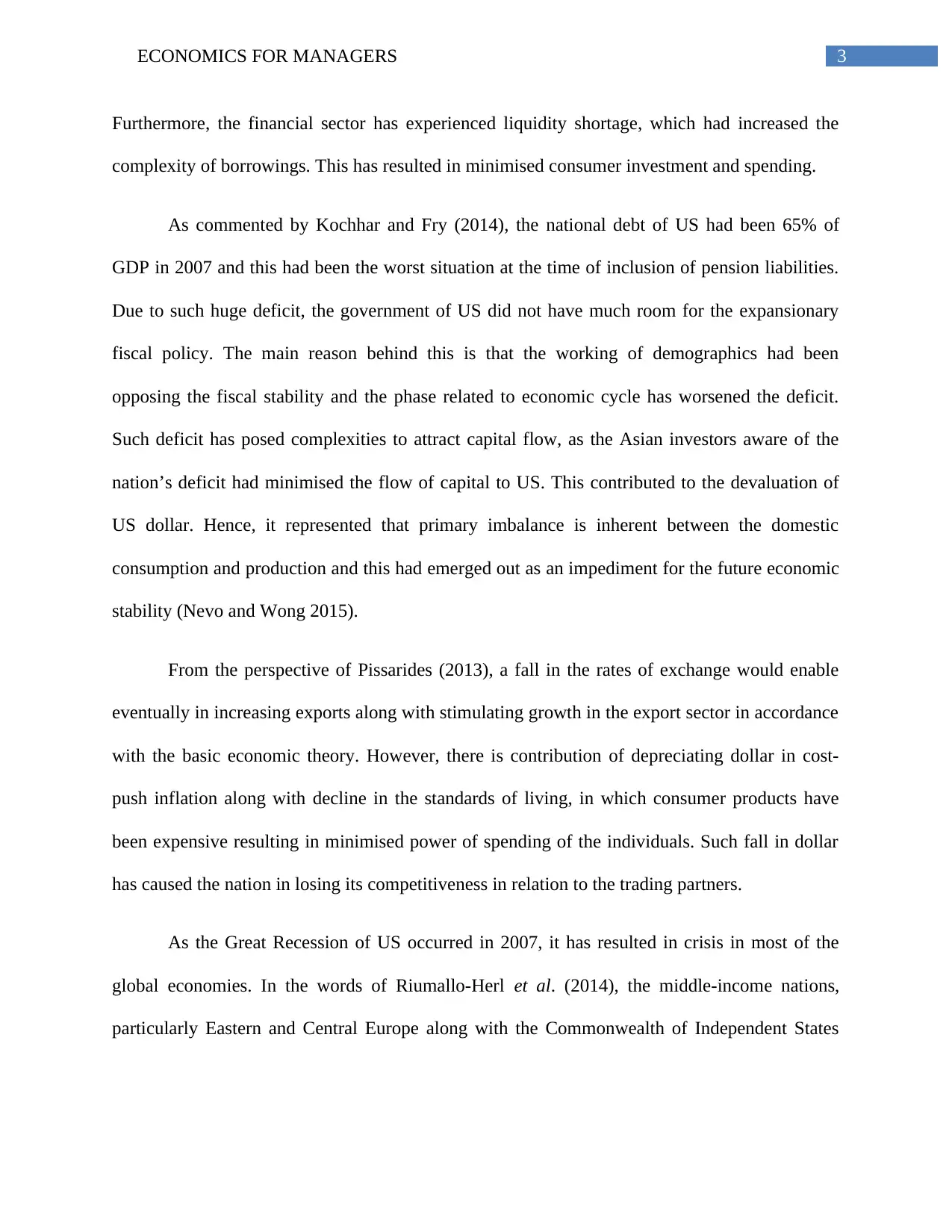
3ECONOMICS FOR MANAGERS
Furthermore, the financial sector has experienced liquidity shortage, which had increased the
complexity of borrowings. This has resulted in minimised consumer investment and spending.
As commented by Kochhar and Fry (2014), the national debt of US had been 65% of
GDP in 2007 and this had been the worst situation at the time of inclusion of pension liabilities.
Due to such huge deficit, the government of US did not have much room for the expansionary
fiscal policy. The main reason behind this is that the working of demographics had been
opposing the fiscal stability and the phase related to economic cycle has worsened the deficit.
Such deficit has posed complexities to attract capital flow, as the Asian investors aware of the
nation’s deficit had minimised the flow of capital to US. This contributed to the devaluation of
US dollar. Hence, it represented that primary imbalance is inherent between the domestic
consumption and production and this had emerged out as an impediment for the future economic
stability (Nevo and Wong 2015).
From the perspective of Pissarides (2013), a fall in the rates of exchange would enable
eventually in increasing exports along with stimulating growth in the export sector in accordance
with the basic economic theory. However, there is contribution of depreciating dollar in cost-
push inflation along with decline in the standards of living, in which consumer products have
been expensive resulting in minimised power of spending of the individuals. Such fall in dollar
has caused the nation in losing its competitiveness in relation to the trading partners.
As the Great Recession of US occurred in 2007, it has resulted in crisis in most of the
global economies. In the words of Riumallo-Herl et al. (2014), the middle-income nations,
particularly Eastern and Central Europe along with the Commonwealth of Independent States
Furthermore, the financial sector has experienced liquidity shortage, which had increased the
complexity of borrowings. This has resulted in minimised consumer investment and spending.
As commented by Kochhar and Fry (2014), the national debt of US had been 65% of
GDP in 2007 and this had been the worst situation at the time of inclusion of pension liabilities.
Due to such huge deficit, the government of US did not have much room for the expansionary
fiscal policy. The main reason behind this is that the working of demographics had been
opposing the fiscal stability and the phase related to economic cycle has worsened the deficit.
Such deficit has posed complexities to attract capital flow, as the Asian investors aware of the
nation’s deficit had minimised the flow of capital to US. This contributed to the devaluation of
US dollar. Hence, it represented that primary imbalance is inherent between the domestic
consumption and production and this had emerged out as an impediment for the future economic
stability (Nevo and Wong 2015).
From the perspective of Pissarides (2013), a fall in the rates of exchange would enable
eventually in increasing exports along with stimulating growth in the export sector in accordance
with the basic economic theory. However, there is contribution of depreciating dollar in cost-
push inflation along with decline in the standards of living, in which consumer products have
been expensive resulting in minimised power of spending of the individuals. Such fall in dollar
has caused the nation in losing its competitiveness in relation to the trading partners.
As the Great Recession of US occurred in 2007, it has resulted in crisis in most of the
global economies. In the words of Riumallo-Herl et al. (2014), the middle-income nations,
particularly Eastern and Central Europe along with the Commonwealth of Independent States
Paraphrase This Document
Need a fresh take? Get an instant paraphrase of this document with our AI Paraphraser
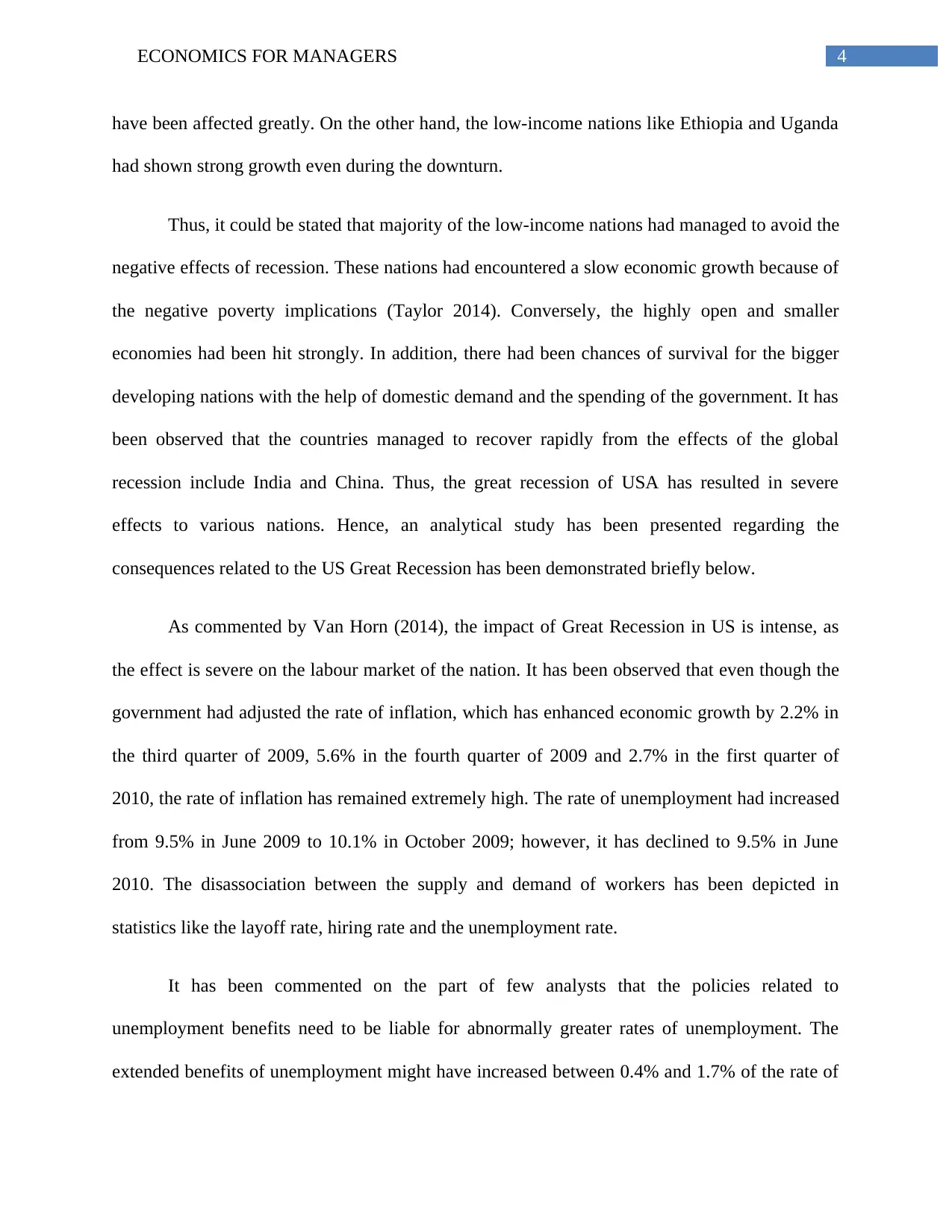
4ECONOMICS FOR MANAGERS
have been affected greatly. On the other hand, the low-income nations like Ethiopia and Uganda
had shown strong growth even during the downturn.
Thus, it could be stated that majority of the low-income nations had managed to avoid the
negative effects of recession. These nations had encountered a slow economic growth because of
the negative poverty implications (Taylor 2014). Conversely, the highly open and smaller
economies had been hit strongly. In addition, there had been chances of survival for the bigger
developing nations with the help of domestic demand and the spending of the government. It has
been observed that the countries managed to recover rapidly from the effects of the global
recession include India and China. Thus, the great recession of USA has resulted in severe
effects to various nations. Hence, an analytical study has been presented regarding the
consequences related to the US Great Recession has been demonstrated briefly below.
As commented by Van Horn (2014), the impact of Great Recession in US is intense, as
the effect is severe on the labour market of the nation. It has been observed that even though the
government had adjusted the rate of inflation, which has enhanced economic growth by 2.2% in
the third quarter of 2009, 5.6% in the fourth quarter of 2009 and 2.7% in the first quarter of
2010, the rate of inflation has remained extremely high. The rate of unemployment had increased
from 9.5% in June 2009 to 10.1% in October 2009; however, it has declined to 9.5% in June
2010. The disassociation between the supply and demand of workers has been depicted in
statistics like the layoff rate, hiring rate and the unemployment rate.
It has been commented on the part of few analysts that the policies related to
unemployment benefits need to be liable for abnormally greater rates of unemployment. The
extended benefits of unemployment might have increased between 0.4% and 1.7% of the rate of
have been affected greatly. On the other hand, the low-income nations like Ethiopia and Uganda
had shown strong growth even during the downturn.
Thus, it could be stated that majority of the low-income nations had managed to avoid the
negative effects of recession. These nations had encountered a slow economic growth because of
the negative poverty implications (Taylor 2014). Conversely, the highly open and smaller
economies had been hit strongly. In addition, there had been chances of survival for the bigger
developing nations with the help of domestic demand and the spending of the government. It has
been observed that the countries managed to recover rapidly from the effects of the global
recession include India and China. Thus, the great recession of USA has resulted in severe
effects to various nations. Hence, an analytical study has been presented regarding the
consequences related to the US Great Recession has been demonstrated briefly below.
As commented by Van Horn (2014), the impact of Great Recession in US is intense, as
the effect is severe on the labour market of the nation. It has been observed that even though the
government had adjusted the rate of inflation, which has enhanced economic growth by 2.2% in
the third quarter of 2009, 5.6% in the fourth quarter of 2009 and 2.7% in the first quarter of
2010, the rate of inflation has remained extremely high. The rate of unemployment had increased
from 9.5% in June 2009 to 10.1% in October 2009; however, it has declined to 9.5% in June
2010. The disassociation between the supply and demand of workers has been depicted in
statistics like the layoff rate, hiring rate and the unemployment rate.
It has been commented on the part of few analysts that the policies related to
unemployment benefits need to be liable for abnormally greater rates of unemployment. The
extended benefits of unemployment might have increased between 0.4% and 1.7% of the rate of
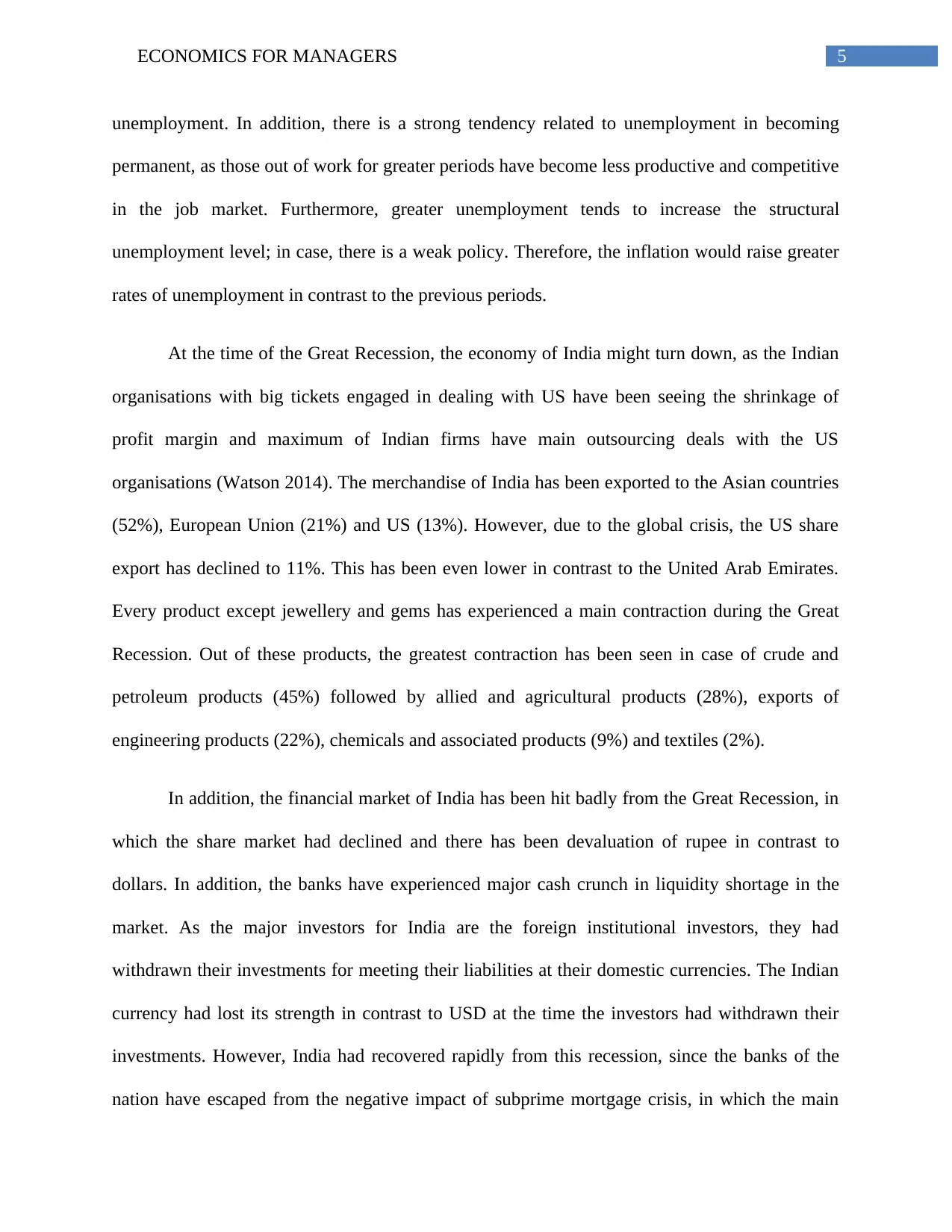
5ECONOMICS FOR MANAGERS
unemployment. In addition, there is a strong tendency related to unemployment in becoming
permanent, as those out of work for greater periods have become less productive and competitive
in the job market. Furthermore, greater unemployment tends to increase the structural
unemployment level; in case, there is a weak policy. Therefore, the inflation would raise greater
rates of unemployment in contrast to the previous periods.
At the time of the Great Recession, the economy of India might turn down, as the Indian
organisations with big tickets engaged in dealing with US have been seeing the shrinkage of
profit margin and maximum of Indian firms have main outsourcing deals with the US
organisations (Watson 2014). The merchandise of India has been exported to the Asian countries
(52%), European Union (21%) and US (13%). However, due to the global crisis, the US share
export has declined to 11%. This has been even lower in contrast to the United Arab Emirates.
Every product except jewellery and gems has experienced a main contraction during the Great
Recession. Out of these products, the greatest contraction has been seen in case of crude and
petroleum products (45%) followed by allied and agricultural products (28%), exports of
engineering products (22%), chemicals and associated products (9%) and textiles (2%).
In addition, the financial market of India has been hit badly from the Great Recession, in
which the share market had declined and there has been devaluation of rupee in contrast to
dollars. In addition, the banks have experienced major cash crunch in liquidity shortage in the
market. As the major investors for India are the foreign institutional investors, they had
withdrawn their investments for meeting their liabilities at their domestic currencies. The Indian
currency had lost its strength in contrast to USD at the time the investors had withdrawn their
investments. However, India had recovered rapidly from this recession, since the banks of the
nation have escaped from the negative impact of subprime mortgage crisis, in which the main
unemployment. In addition, there is a strong tendency related to unemployment in becoming
permanent, as those out of work for greater periods have become less productive and competitive
in the job market. Furthermore, greater unemployment tends to increase the structural
unemployment level; in case, there is a weak policy. Therefore, the inflation would raise greater
rates of unemployment in contrast to the previous periods.
At the time of the Great Recession, the economy of India might turn down, as the Indian
organisations with big tickets engaged in dealing with US have been seeing the shrinkage of
profit margin and maximum of Indian firms have main outsourcing deals with the US
organisations (Watson 2014). The merchandise of India has been exported to the Asian countries
(52%), European Union (21%) and US (13%). However, due to the global crisis, the US share
export has declined to 11%. This has been even lower in contrast to the United Arab Emirates.
Every product except jewellery and gems has experienced a main contraction during the Great
Recession. Out of these products, the greatest contraction has been seen in case of crude and
petroleum products (45%) followed by allied and agricultural products (28%), exports of
engineering products (22%), chemicals and associated products (9%) and textiles (2%).
In addition, the financial market of India has been hit badly from the Great Recession, in
which the share market had declined and there has been devaluation of rupee in contrast to
dollars. In addition, the banks have experienced major cash crunch in liquidity shortage in the
market. As the major investors for India are the foreign institutional investors, they had
withdrawn their investments for meeting their liabilities at their domestic currencies. The Indian
currency had lost its strength in contrast to USD at the time the investors had withdrawn their
investments. However, India had recovered rapidly from this recession, since the banks of the
nation have escaped from the negative impact of subprime mortgage crisis, in which the main
⊘ This is a preview!⊘
Do you want full access?
Subscribe today to unlock all pages.

Trusted by 1+ million students worldwide
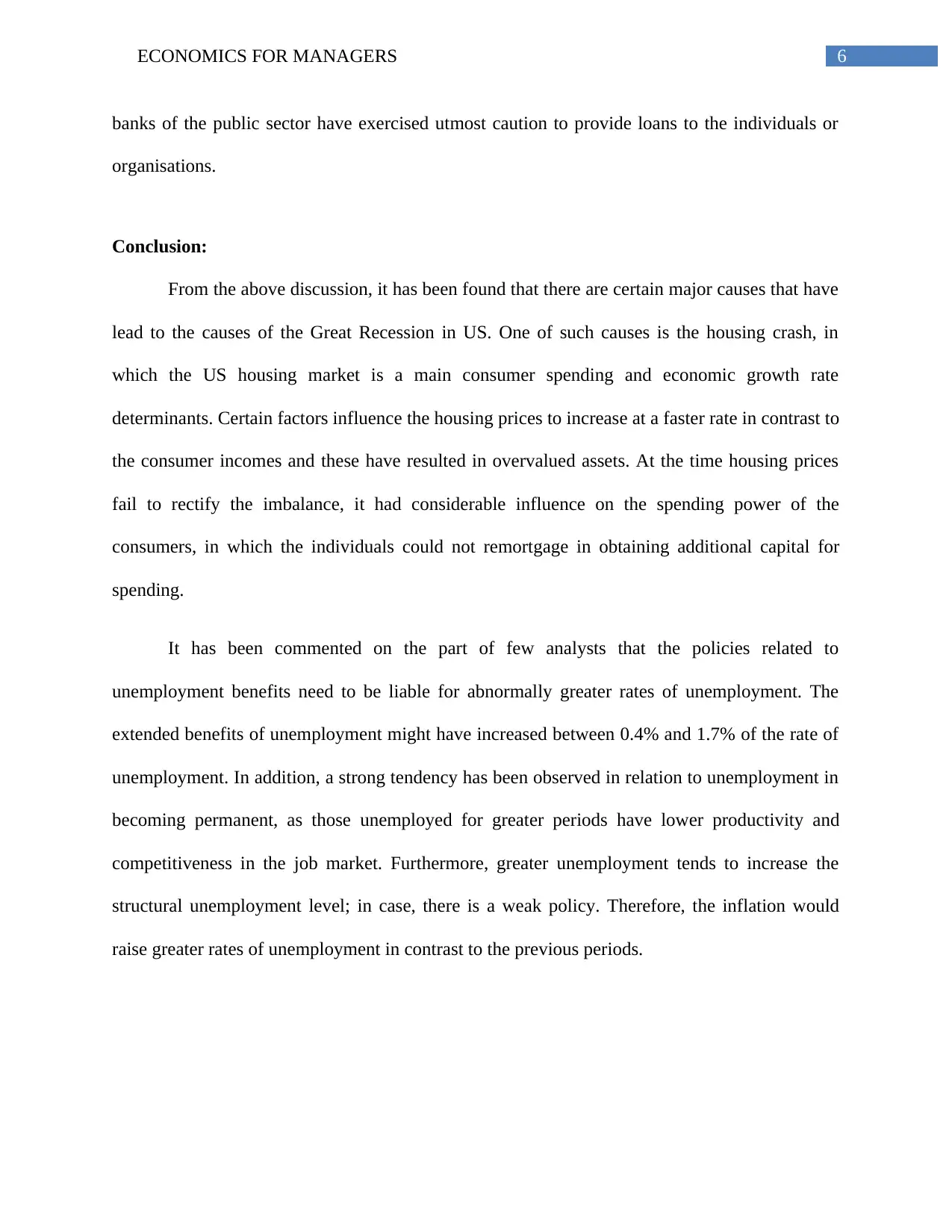
6ECONOMICS FOR MANAGERS
banks of the public sector have exercised utmost caution to provide loans to the individuals or
organisations.
Conclusion:
From the above discussion, it has been found that there are certain major causes that have
lead to the causes of the Great Recession in US. One of such causes is the housing crash, in
which the US housing market is a main consumer spending and economic growth rate
determinants. Certain factors influence the housing prices to increase at a faster rate in contrast to
the consumer incomes and these have resulted in overvalued assets. At the time housing prices
fail to rectify the imbalance, it had considerable influence on the spending power of the
consumers, in which the individuals could not remortgage in obtaining additional capital for
spending.
It has been commented on the part of few analysts that the policies related to
unemployment benefits need to be liable for abnormally greater rates of unemployment. The
extended benefits of unemployment might have increased between 0.4% and 1.7% of the rate of
unemployment. In addition, a strong tendency has been observed in relation to unemployment in
becoming permanent, as those unemployed for greater periods have lower productivity and
competitiveness in the job market. Furthermore, greater unemployment tends to increase the
structural unemployment level; in case, there is a weak policy. Therefore, the inflation would
raise greater rates of unemployment in contrast to the previous periods.
banks of the public sector have exercised utmost caution to provide loans to the individuals or
organisations.
Conclusion:
From the above discussion, it has been found that there are certain major causes that have
lead to the causes of the Great Recession in US. One of such causes is the housing crash, in
which the US housing market is a main consumer spending and economic growth rate
determinants. Certain factors influence the housing prices to increase at a faster rate in contrast to
the consumer incomes and these have resulted in overvalued assets. At the time housing prices
fail to rectify the imbalance, it had considerable influence on the spending power of the
consumers, in which the individuals could not remortgage in obtaining additional capital for
spending.
It has been commented on the part of few analysts that the policies related to
unemployment benefits need to be liable for abnormally greater rates of unemployment. The
extended benefits of unemployment might have increased between 0.4% and 1.7% of the rate of
unemployment. In addition, a strong tendency has been observed in relation to unemployment in
becoming permanent, as those unemployed for greater periods have lower productivity and
competitiveness in the job market. Furthermore, greater unemployment tends to increase the
structural unemployment level; in case, there is a weak policy. Therefore, the inflation would
raise greater rates of unemployment in contrast to the previous periods.
Paraphrase This Document
Need a fresh take? Get an instant paraphrase of this document with our AI Paraphraser
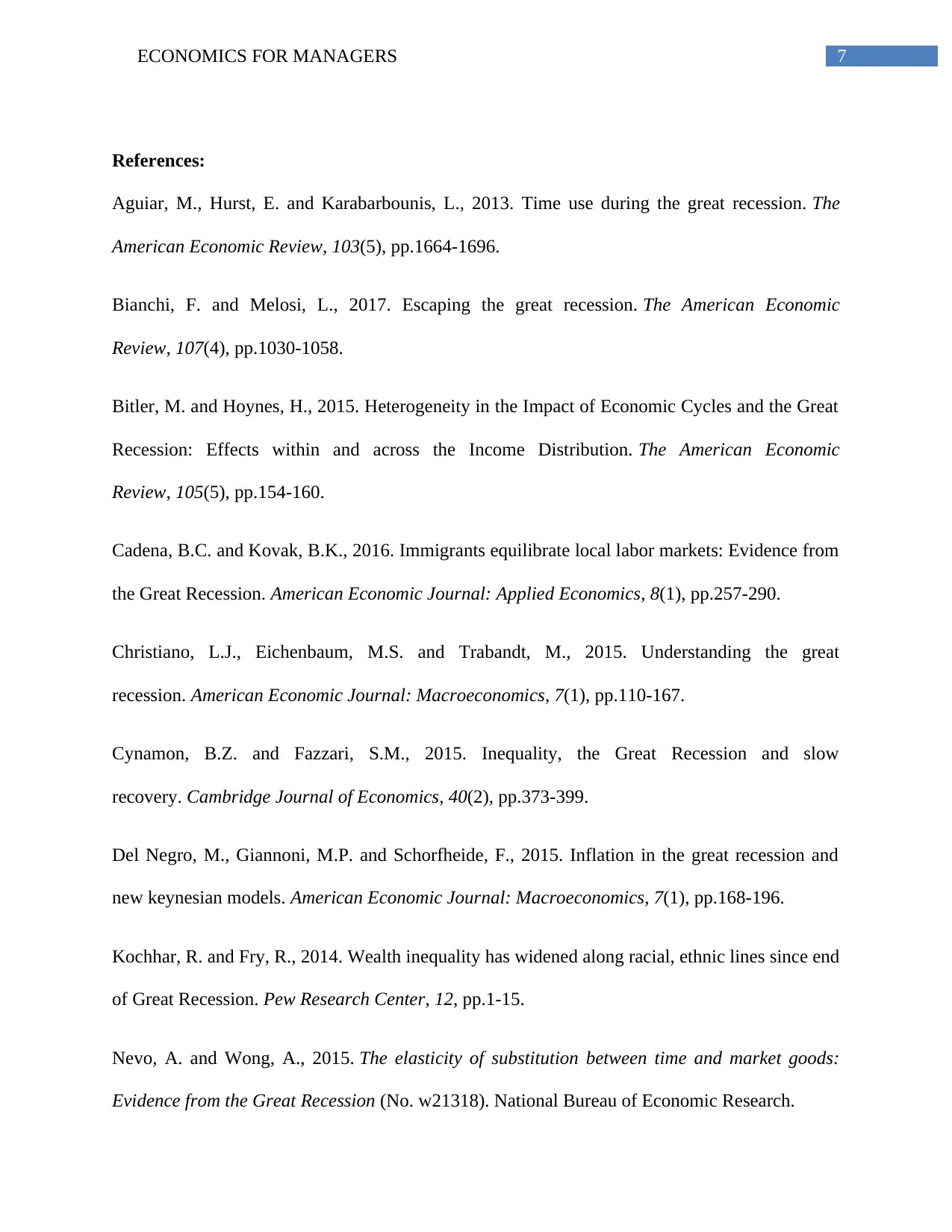
7ECONOMICS FOR MANAGERS
References:
Aguiar, M., Hurst, E. and Karabarbounis, L., 2013. Time use during the great recession. The
American Economic Review, 103(5), pp.1664-1696.
Bianchi, F. and Melosi, L., 2017. Escaping the great recession. The American Economic
Review, 107(4), pp.1030-1058.
Bitler, M. and Hoynes, H., 2015. Heterogeneity in the Impact of Economic Cycles and the Great
Recession: Effects within and across the Income Distribution. The American Economic
Review, 105(5), pp.154-160.
Cadena, B.C. and Kovak, B.K., 2016. Immigrants equilibrate local labor markets: Evidence from
the Great Recession. American Economic Journal: Applied Economics, 8(1), pp.257-290.
Christiano, L.J., Eichenbaum, M.S. and Trabandt, M., 2015. Understanding the great
recession. American Economic Journal: Macroeconomics, 7(1), pp.110-167.
Cynamon, B.Z. and Fazzari, S.M., 2015. Inequality, the Great Recession and slow
recovery. Cambridge Journal of Economics, 40(2), pp.373-399.
Del Negro, M., Giannoni, M.P. and Schorfheide, F., 2015. Inflation in the great recession and
new keynesian models. American Economic Journal: Macroeconomics, 7(1), pp.168-196.
Kochhar, R. and Fry, R., 2014. Wealth inequality has widened along racial, ethnic lines since end
of Great Recession. Pew Research Center, 12, pp.1-15.
Nevo, A. and Wong, A., 2015. The elasticity of substitution between time and market goods:
Evidence from the Great Recession (No. w21318). National Bureau of Economic Research.
References:
Aguiar, M., Hurst, E. and Karabarbounis, L., 2013. Time use during the great recession. The
American Economic Review, 103(5), pp.1664-1696.
Bianchi, F. and Melosi, L., 2017. Escaping the great recession. The American Economic
Review, 107(4), pp.1030-1058.
Bitler, M. and Hoynes, H., 2015. Heterogeneity in the Impact of Economic Cycles and the Great
Recession: Effects within and across the Income Distribution. The American Economic
Review, 105(5), pp.154-160.
Cadena, B.C. and Kovak, B.K., 2016. Immigrants equilibrate local labor markets: Evidence from
the Great Recession. American Economic Journal: Applied Economics, 8(1), pp.257-290.
Christiano, L.J., Eichenbaum, M.S. and Trabandt, M., 2015. Understanding the great
recession. American Economic Journal: Macroeconomics, 7(1), pp.110-167.
Cynamon, B.Z. and Fazzari, S.M., 2015. Inequality, the Great Recession and slow
recovery. Cambridge Journal of Economics, 40(2), pp.373-399.
Del Negro, M., Giannoni, M.P. and Schorfheide, F., 2015. Inflation in the great recession and
new keynesian models. American Economic Journal: Macroeconomics, 7(1), pp.168-196.
Kochhar, R. and Fry, R., 2014. Wealth inequality has widened along racial, ethnic lines since end
of Great Recession. Pew Research Center, 12, pp.1-15.
Nevo, A. and Wong, A., 2015. The elasticity of substitution between time and market goods:
Evidence from the Great Recession (No. w21318). National Bureau of Economic Research.

8ECONOMICS FOR MANAGERS
Pissarides, C.A., 2013. Unemployment in the great recession. Economica, 80(319), pp.385-403.
Riumallo-Herl, C., Basu, S., Stuckler, D., Courtin, E. and Avendano, M., 2014. Job loss, wealth
and depression during the Great Recession in the USA and Europe. International journal of
epidemiology, 43(5), pp.1508-1517.
Taylor, J.B., 2014. The role of policy in the great recession and the weak recovery. The
American Economic Review, 104(5), pp.61-66.
Van Horn, C.E., 2014. Working scared (or not at all): The lost decade, great recession, and
restoring the shattered American dream. Rowman & Littlefield.
Watson, M.W., 2014. Inflation Persistence, the NAIRU, and the Great Recession. The American
Economic Review, 104(5), pp.31-36.
Pissarides, C.A., 2013. Unemployment in the great recession. Economica, 80(319), pp.385-403.
Riumallo-Herl, C., Basu, S., Stuckler, D., Courtin, E. and Avendano, M., 2014. Job loss, wealth
and depression during the Great Recession in the USA and Europe. International journal of
epidemiology, 43(5), pp.1508-1517.
Taylor, J.B., 2014. The role of policy in the great recession and the weak recovery. The
American Economic Review, 104(5), pp.61-66.
Van Horn, C.E., 2014. Working scared (or not at all): The lost decade, great recession, and
restoring the shattered American dream. Rowman & Littlefield.
Watson, M.W., 2014. Inflation Persistence, the NAIRU, and the Great Recession. The American
Economic Review, 104(5), pp.31-36.
⊘ This is a preview!⊘
Do you want full access?
Subscribe today to unlock all pages.

Trusted by 1+ million students worldwide
1 out of 9
Related Documents
Your All-in-One AI-Powered Toolkit for Academic Success.
+13062052269
info@desklib.com
Available 24*7 on WhatsApp / Email
![[object Object]](/_next/static/media/star-bottom.7253800d.svg)
Unlock your academic potential
Copyright © 2020–2025 A2Z Services. All Rights Reserved. Developed and managed by ZUCOL.





